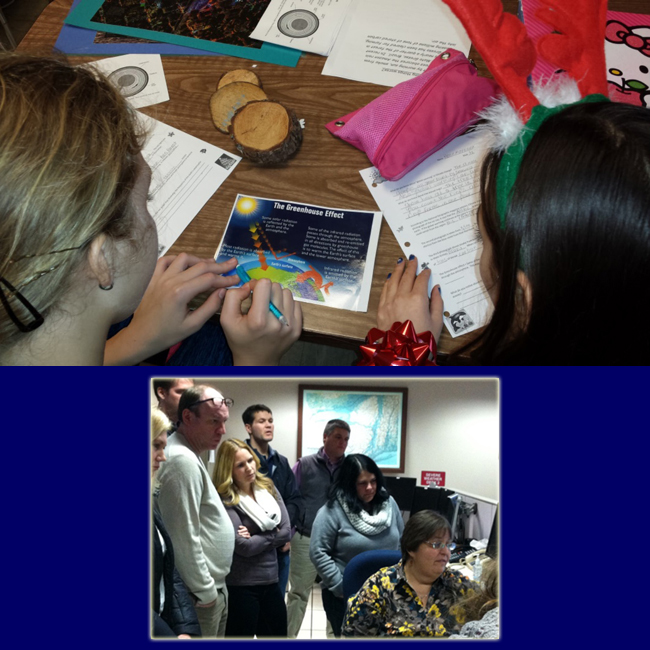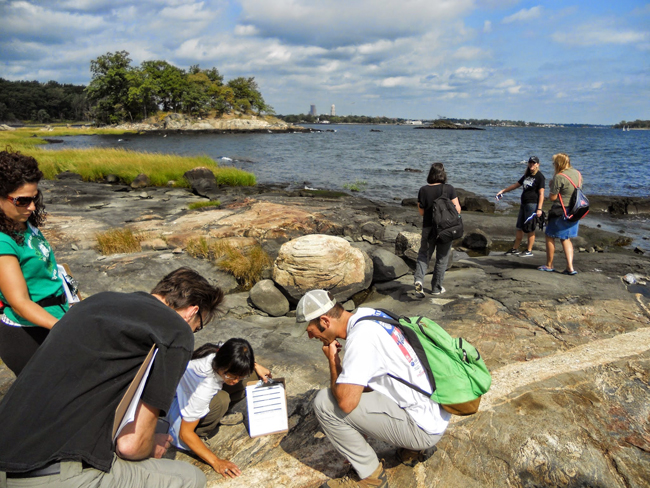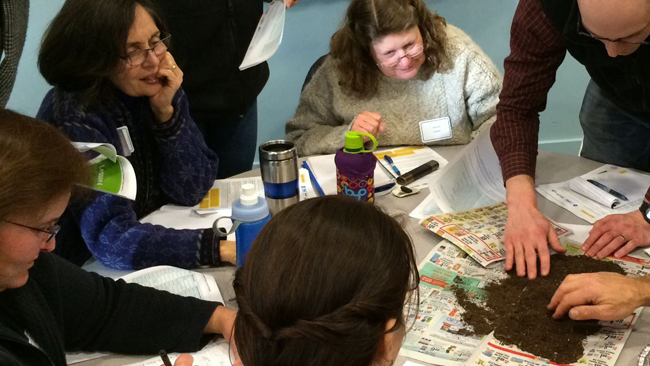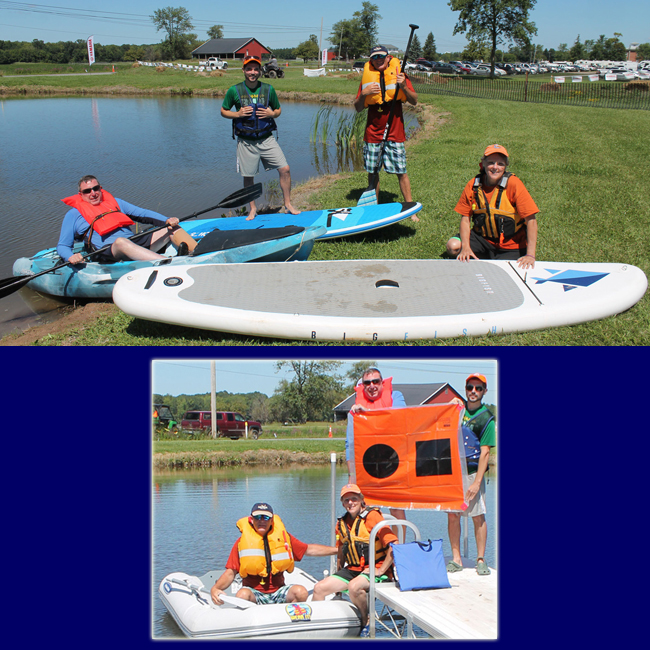Sea Grant's efforts to teach an environmentally literate public and train a skilled marine and coastal workforce span ages and generations.
Washington, D.C., January 13, 2017 - Earlier this year, a "K to Gray" Education Story Map was unveiled by the National Oceanic and Atmospheric Administration's National Sea Grant Office to mark the program's 50th anniversary.
This interactive online feature showcases the value and impact of Sea Grant education program from coast-to-coast, highlighting activities for youth, university and adult levels from Sea Grant's network of 33 U.S. programs.
As you click through the education story maps you will notice markers for New York Sea Grant efforts on each of the category tabs:
- Adult-level (Suddenly-in-Command)
- University-level (Sound Stewards)
- Youth-level (Climate Change Lesson Plans)
Our program's information can also be found below.
For a variety of web stories that highlight Sea Grant's education programs throughout the country, visit NOAA's National Sea Grant Web site [http://seagrant.noaa.gov/education].
More Info: A Sampling of NYSG's K to Gray Resources
1. Advancing Great Lakes Education: From Algae to Zooplankton
Audience: Youth
Contact: Helen Domske, NYSG's Coastal Education Specialist, E:
hmd4@cornell.edu

Using the “teach-the-teacher” workshop approach in which teachers interact with scientists, NYSG coastal education programming prepares hundreds of teachers to educate and engage thousands of students as the next generation of Great Lakes-literate citizens, providing them with classroom-tested curriculum developed by Sea Grant and NOAA, and encouraging infusion of Great Lakes information, from algal blooms to zooplankton, into classrooms.
More Info:
New York Sea Grant Posts Impact Statements for Great Lakes and Marine District Projects
NYSG Advancing Great Lakes Education: From Algae to Zooplankton (pdf)
2. Long Island Sound Stewards Program
Audience: Youth
Contact:
Anna Meili Weshner-Dunning, NYSG's Long Island Sound Study Outreach Specialist, E: Amw392@cornell.edu

For the last several years, the Sound Stewards program has engaged more than 3,500 K-12 and college students in citizen science research projects at Long Island Sound Stewardship Areas that have led to further restoration of important habitats and ecosystem.
More Info:
A Day in the life of the Nissequogue River
Created by Mrs. Marlowes Environmental science classes. Sachem North high school Ronkonkoma NY
Hands-On Teacher Workshops a “Re-Sounding” Success
Long Island Sound Study
3. Providing Teachers Place-Based Lesson Plans to Increase Climate Literacy
Audience: Youth
Contact: Nordica Holochuck, NYSG's Hudson Estuary Specialist, E: nch8@cornell.edu

The Climate Change Lesson Plans in this series help middle school students understand climate and weather basics and explore climate change-related issues close to home in New York’s Hudson River Valley, while being easily adapted to different regions of the US as they rely on easily-accessible NOAA data sets.
More Info:
Hudson River Estuary Climate Change Lesson Project
4. Suddenly-In-Command Education Focuses on Boater Safety
Audience: Adult
Contact: David White, NYSG's Recreation and Tourism Specialist, E: dgw9@cornell.edu

With New York’s status as a Top 10 state for the number of registered boats, NYSG’s “Suddenly-In-Command” educational program empowers non-boater passengers to act in the event of an onboard emergency by teaching them how to assess an emergency situation, stabilize the vessel and potentially pilot it to shore, properly signal distress and summon assistance using various devices.
More Info:
New York Sea Grant Posts Impact Statements for Great Lakes and Marine District Projects
Suddenly-In-Command Education Focused on Safety (pdf)
5. Coastal Storm Awareness Program video
Audience: Adult
Contact: Paul C. Focazio, NYSG's Interim Communications Manager, E: paul.focazio@stonybrook.edu
The 4-1/2 minute trailer for NOAA Sea Grant's Coastal Storm Awareness Program's 23-minute documentary, view-able on YouTube.
Responding to Superstorm Sandy, the Connecticut, New York and New Jersey Sea Grant programs administered ten social science research projects, supported with outreach, under the $1.8M NOAA-funded Coastal Storm Awareness Program to understand factors that influenced coastal resident actions related to Sandy storm warnings and to improve clarity of future storm warnings, the results of which are summarized in a NYSG-produced video.
More Info:
On YouTube: NOAA Sea Grant Coastal Storm Awareness Program Comes Ashore
More Info: New York Sea Grant
New York Sea Grant (NYSG), a cooperative program of Cornell University
and the State University of New York, is one of 33 university-based
programs under the National Sea Grant College Program (NSGCP) of the
National Oceanic and Atmospheric Administration (NOAA). The NSGCP
engages this network of the nation’s top universities in conducting
scientific research, education, training and extension projects designed
to foster science-based decisions about the use and conservation of our
aquatic resources. Through its statewide network of integrated
services, NYSG has been promoting coastal vitality, environmental
sustainability, and citizen awareness about the State’s marine and Great
Lakes resources since 1971.
New York Sea Grant maintains Great Lakes offices at SUNY Buffalo, the
Wayne County Cooperative Extension office in Newark and at SUNY Oswego.
In the State's marine waters, NYSG has offices at Stony Brook University
and Stony Brook Manhattan, in the Hudson Valley through Cooperative
Extension in Kingston and at Brooklyn College.
For updates on Sea Grant activities: www.nyseagrant.org has RSS, Facebook, Twitter, and YouTube links. NYSG produces a monthly e-newsletter, "NOAA Sea Grant's Social Media Review," via its blog, www.nyseagrant.org/blog. Our program also offers a free e-list sign up via www.nyseagrant.org/coastlines for its flagship publication, NY Coastlines/Currents, which is published 1-2 times a year.